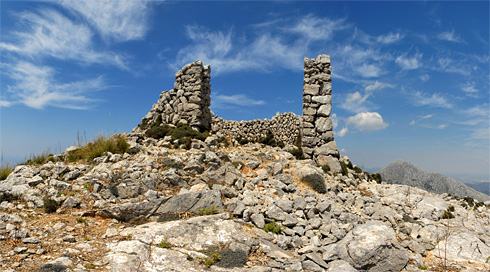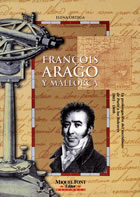The Serra de Tramuntana and the spy
Hikers who visit Mola de s'Esclop invariably wonder about the origins of the ruins that crown the said peak. What could they be? An ice store? A limekiln? The remains that have withstood the passing of time are in fact the ruins of a hut commissioned by François Arago when he was making astronomical observations in the Serra de Tramuntana.
François Arago was 19 years old when he was entrusted with continuing the job that André Mechain had started some years earlier of measuring the Paris meridian. Astronomer Méchain was involved in an important mission when he died: to take a measurement from nature that could be used as a standard measure. This measure would be called a metre and it would serve to unify measurement systems worldwide. This was a revolutionary cross-border idea, aimed at serving "all nations forever".
To achieve a system based on a natural phenomenon rather than on the palm of the hand of the king in question, the French decided that a metre would be represented by a ten millionth part of the quadrant of the Paris meridian. Having established these premises, all that was left was to measure the meridian arc. The objective of the first expedition by Méchain and Delambre was to measure the arc between Dunkirk, in northern France, and Barcelona. Later, they decided to extend the arc further south and reach the Balearic Islands. André Méchain died in Castellón during the expedition and he was replaced by the young Arago. Born in Roussillon, François Arago spoke Catalan, and this played a determining role when he was chosen to continue the mission.

The "Frenchman's hut", as it was popularly known, was really a small astronomical observatory
The Madrid uprising against the French on May 2nd 1808 and the ensuing events of May 3rd caught this brilliant young man unawares on top of Mola de s'Esclop, in the hut that he was using to take his measurements. The "caseta del francès", as it was popularly known, was really a small astronomical observatory. From it, he was measuring angles between Mola de s'Esclop, Formentera, and the top of Camp Vell in Ibiza. This process of triangulation united three islands and it was technically complex since it was being done over the sea. Measurements were taken by lighting fires on the different peaks and calculating the distance between them, using very powerful lenses. These smoke signals aroused suspicion among the local populace. However, it was not until late May, when news reached the Balearics of the uprising against the French on mainland Spain, that Arago found himself in real danger. The local peasants suddenly remembered the Frenchman who lit fires each night to send signals to his colleagues, and they climbed the mountain in search of him, convinced that he must be a spy.
One of the Spaniards involved in the expedition found out and ran to the top of the mountain to warn him. Arago disguised himself in peasant clothes and set off down to Palma. Unfortunately, he was intercepted by the group who had come to take him prisoner. It was then that he took advantage of his linguistic skills. Arago was very good at imitating accents and so he could speak perfect Mallorcan. He informed them that the French spy they were after was on top of the mountain. The peasants carried on up the slope and Arago managed to reach Palma safe and sound, with all the calculations from his observations. In Palma, he demanded protection and was confined, as a result, in Bellver Castle, occupying the same room as former prisoner Jovellanos prior to his release some years earlier. It was not until two months later that the same person that had helped him disguise himself as a peasant - a skipper by the name of Damià - managed to find a small boat for him to escape. Reaching France was no easy task, given the war, but finally, after nearly a year, he managed it.
Thus the hut that was left in the Serra de Tramuntana once bore witness to one of the 19th century's scientific quests, in a romantic story of spies that were not really spies, young mountaineers and triangulators of peaks, and exploits in defence of Reason. In short, the hut is a reminder of Mallorca's contribution to that scientific expedition that set out to measure the world.
Text by Alícia Vicens
Translated by Rachel Waters
Did you know that...
Jules Verne knew François Arago and he wrote several novels inspired by his adventures. Famous as the forerunner of science fiction, Verne held long conversations with Arago and his brothers in Paris. As a result, he became an enthusiastic fan of geodesic expeditions. The Adventures of Three Englishmen and Three Russians in South Africa, Eight Hundred Leagues on the Amazon and Clovis Dardentor are some examples of novels by Verne that reflect this fascination for astronomical observations and the creation of the metric system.
Bibliography

François Arago y Mallorca
An outline of François Arago's experiences in the Balearics, also featuring hitherto unpublished historical documents and numerous anecdotes about this almost ill fated enterprise. It describes how two nations - Spain and France - came together to measure the shape of the Earth and how they were subsequently distanced by the Spanish War of Independence.
Author: Elena Ortega
Published by: Miquel Font
Published in: 1999
www.miquelfonteditor.com




